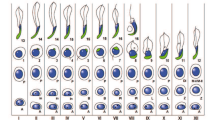Summary
The testes from three months old Spague-Dawley rats were fixed in Bouin's fluid or neutral buffered 10% formalin, embedded in paraffin, sectioned and after deparaffination stained with the following fluorescein isothiocyanate coupled lectins: PNA, WGA, Con A, RCA, SBA, DBA and UEA. The results show that there are considerable differences in the staining pattern of various spermatogenic cells between different lectins. The fixation in Bouin's fluid enhanced the staining of all the lectins compared to formalin fixation in which only a weak staining could be seen in the acrosomes of spermatids after WGA or PNA staining. PNA and WGA stained specifically the acrosome of the developing spermatids, which was seen from the beginning of the acrosome formation and lasted up to late spermiogenesis. However, the staining with PNA decreased in the late spermatids whereas the intensity of the staining remained unchanged with WGA. Con A did not stain the acrosome but stained unspecifically the cytoplasm of all spermatogenic cells. RCA stained faintly the acrosome throughout the spermatid differentiation. DBA and UEA stained specifically the chromosomes of B spermatogonia. DBA also faintly stained the cell membranes of early spermatids. SBA did not show any specific staining of the spermatogenic cells. Based on this it is suggested that the carbohydrates and glycoproteins which are known to be present in the acrosome are formed already in the beginning of the acrosome formation. The decrease in the PNA staining in late spermatids possibly reflects the fact that the receptor molecules are not synthesized in late spermatids but are formed in earlier developmental stages and are thereafter preserved in the acrosome. The enhancement of lectin binding caused by Bouin's fixative might also be applied to other tissues where previous experiments with formalin fixed tissue have failed to show any staining.
Similar content being viewed by others
References
Disbrey BD, Rack JR (1970) Histological laboratory methods. E & S. Livingstone, Edinburgh London
Freeman HJ, Lotan R, Kim YS (1980) Application of lectins for detection of goblet cell glycoconjugate differences in proximal and distal colon of the rat. Lab Invest 42:405–412
Gould SF, Bernstein MH (1975) The localization of bovine sperm hyaluronidase. Differentation 3:123
Gould SF, Bernstain MH (1977) Cytochemistry of spermatozoa. In: Hafez ESE (ed) Techniques of human andrology. Elsevier North Holland Biomedical Press, Amsterdam, pp 189–207
Jacobson W, Stoddard RW, Collins RD (1980) Lectin staining of carbohydrates of haemic cells. II. The cells of normal lymphoid origin, of lymphatic leukaemias and related diseases. Histopathology 4:491–506
Leblond CP, Clermont Y (1952) Definition of the stages of the cycle of the seminiferous epithelium in the rat. Ann NY Acad Sci 55:548–573
McIlhinney RAJ, Patel S (1981) A peanut binding protein present on human teratome derived cell lines. In: Anderson CK, Jones WG, Ward AM (eds) Germ cell tumors. Taylor & Francis, London, pp 151–153
Millette CF (1977) Distribution and mobility of lectin binding sites on mammalian spermatozoa. In: Johnson MH, Edidin M (eds) Immunobiology of gametes. Cambridge University Press, London, pp 50–71
Millette CF, Spear PG, Gall WE, Edelman GM (1973) Chemical dissection of mammalian spermatozoa. J Cell Biol 58:662–675
Monesi V (1965) Synthetic activities during spermatogenesis in the mouse. RNA and protein. Exp Cell Res 39:197–224
Newman RA, Klein PJ, Rudland PS (1979) Binding of peanut lectin to breast epithelium, human carcinomas, and a cultured rat mammary stem cell: use of the lectin as a marker of mammalian differentation. J Natl Cancer Inst 63:1339–1346
Söderström K-O, Parvinen M (1976) Incorporation of 3-H-uridine by the chromatoid body during rat spermatogenesis. J Cell Biol 239–251
Thoss K, Roth J (1975) The use of fluorescein isothiocyanate labeled lectins for immunohistochemical demonstration of saccharides. Exp Pathol 11:155–167
Author information
Authors and Affiliations
Rights and permissions
About this article
Cite this article
Söderström, K.O., Malmi, R. & Karjalainen, K. Binding of fluorescein isothiocyanate conjugated lectins to rat spermatogenic cells in tissue sections. Histochemistry 80, 475–579 (1984). https://doi.org/10.1007/BF00553720
Received:
Accepted:
Issue Date:
DOI: https://doi.org/10.1007/BF00553720




